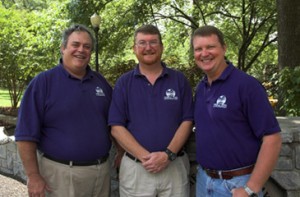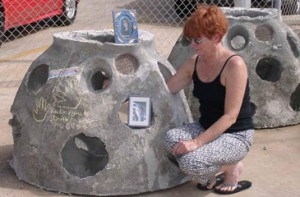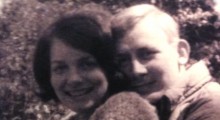George Frankel has served as CEO of Eternal Reefs, Inc. since 2000, and has recently been appointed to the Green Burial Council Advisory Board. All photos courtesy of Eternal Reefs’s website.

Kelly: For those who may not be familiar, what exactly do you do at Eternal Reefs?
George: The simple explanation is we actually take cremated remains and mix them into concrete, which we then make into “reef balls” and place in the ocean. We actually encourage the families to participate in the making of the memorial: they can write messages in the concrete, leave handprints in the concrete, things like that. Overall, it’s a four-day process. The second day is the family fun day, where they can go shopping or whatever they wish while we get the reef ready for viewing. The next day it is ready for viewing, and we give them rubbing wax and paper so they can do rubbings of the plaque that goes with the memorial, and chalk for writing messages. If somebody’s doing military honors, we make sure they get their honors. The fourth day we take the family out on the boat and place the reef down in the water. We give each family the opportunity to go to the site to visit the memorial whenever they wish. In most cases, when somebody passes away, the family is powerless. Having buried everybody in my family, I know that it’s a very frustrating process. It’s great for the family to have a chance to be involved. It becomes more than just a memorial; it’s a personal tribute that they made with their own hands. We like to say it’s a way of healing the sea and the soul.
Kelly: That actually leads me into my next question, which is what’s it like working with people who opt to assist in making the reefs with a loved one’s remains?
George: We have an incredible advantage. It’s one of the beautiful things about choosing something like cremation. When families choose cremation there’s no urgency for a family to do something. They have time to plan and organize and do what they want to do. By the time people come to us, they’ve gone through the grieving process, so we get the best of all worlds. We get families that are willing to talk and we hear some really wonderful stories and about why this was what they wanted to do. We hear the very positive side of what people’s lives were. From our standpoint, we’re getting these people at a very good time. We’re not dealing with the heavy grief cycle.
Kelly: Why do you think more people are turning to cremation nowadays rather than traditional burial?
George: The funeral industry collectively says that cremation equals “cheap.” But every survey with reference to cremation shows that better educated, more affluent people choose cremation. With the current economy, that’s enhanced. People want value. They don’t see the value of something they’re gonna see for two or three hours and then put in the ground and never see again. The value that people used to place on a family cemetery plot is not the same as it used to be. With cremation, people don’t have to make emergency life preparations, like worrying about getting the kids out of school, arranging flights, and so on. They can sit back and say we’ll grieve for Mom, for Dad, and maybe when we all get together at Christmas, we’ll decide what we want to do for a memorial, for a service. It gives families the opportunity to sit back.
The next big thing that’s going to rock the funeral industry is conservation memorialization. That’s going to change their business even more than cremation did. The Green Burial Council is mostly focused on preserving ecosystems on land, but we do the same thing in the ocean. We do it at a fraction of the cost of traditional burial. It’s about feeling good and getting value out of what you’re doing with regards to memorial choice, and giving value to future generations. There’s a huge cost disparity between going with traditional and contemporary burial.
Kelly: I read on your website that back in 1998 Don Brawley’s father-in-law requested to have his remains put in a reef. Was this the first time anyone at Eternal Reefs considered including people’s remains in the reefs?
George: Absolutely, that was the inspiration. I had known that Don had been involved in developing reef ball technology in college. I was also dealing with my mother’s own illness at the time, so I was consciously aware of what was coming, and the things you have to think about. It just made perfect sense. These reefs end up contributing so much. You can track their growth and they really do exactly what they’re supposed to do.

An example of a decorated reef
Kelly: You include lots of helpful information on your website, like sources for grief support and end-of-life-planning. What was the transition like going from purely an environmental focus to such a personal one?
George: When we first started out, we simply didn’t encourage families being involved. We never said they couldn’t, but we didn’t encourage it. We thought, “Who in their right mind would want to roll up their sleeves out here and be part of this process?” But then the story about Ray Brent Marsh came out, about how he wasn’t performing the cremations he promised. The day that that hit the news, it changed everything. And we had brought out 60 third graders to learn how to make these reefs. We thought if we could manage them, we could manage families. We initially just thought families wouldn’t want to be involved. But you can literally watch people change in front of your eyes out here.
Many parents burying their children say that their children didn’t get to live their lives to completion. We had a woman come in whose 21-year-old son took his own life. She had his box of remains clutched tightly to her chest with fists. There was clearly a lot of ownership attached. But then once she started mixing the concrete, things changed. She refused to wash the concrete off her hands. She had tears streaming down her cheeks and a smile on her face. She left looking 15 to 20 years younger. And there had apparently been an ugly divorce between her and her ex-husband. The ex-husband was there with his new wife and new family and this woman was there with her new husband and new family. And they stood with their arms around each other at their son’s memorial. And the man’s ex-wife commented to me that they had never had their families together like this, or seen the two of them get along this way.
You know, we’re reef builders, that’s our background. But we’re learning the value of involvement. All of a sudden, we’re watching the dynamics of these whole family interactions. We had two choices: we could say that’s not our business, or say, “Wow, look at what we’re doing, how we’re helping.” It’s a very positive process, a very healthy process.
Kelly: What advice would you offer to SevenPonds readers regarding end-of-life planning?
George: Families need to talk about what they want for their end-of-life plans. They need to put them in writing. There’s a thing called the Five Wishes Document, it’s available online, and it’s a legally binding document in 40-plus states. It allows you to identify who’s responsible for your end-of-life plans when you’re not able to. When your family does not know what you want done, they don’t know what to do. They need to be clear with these wishes. You don’t have to use the document, but you need to sit down with your family and talk about what you want done and what you want handled. The one thing we know in the funeral business is that nobody is promised tomorrow. Putting these things in place is the greatest gift you can give yourself and your family because you know that people are going to carry out your wishes when you can’t advocate for yourself. Make it easy on your family and have your family make it easy on you. Putting it in writing is the best way you can assure yourself that what you want is going to be followed, and provide the guidance to your family.
Kelly: Thank you so much, Mr. Frankel!

 What is Green Cremation? An Interview with George Frankel
What is Green Cremation? An Interview with George Frankel


 How Dare You Die Now!
How Dare You Die Now!
 Debating Medical Aid in Dying
Debating Medical Aid in Dying
 “Help Me, Helen”
“Help Me, Helen”














